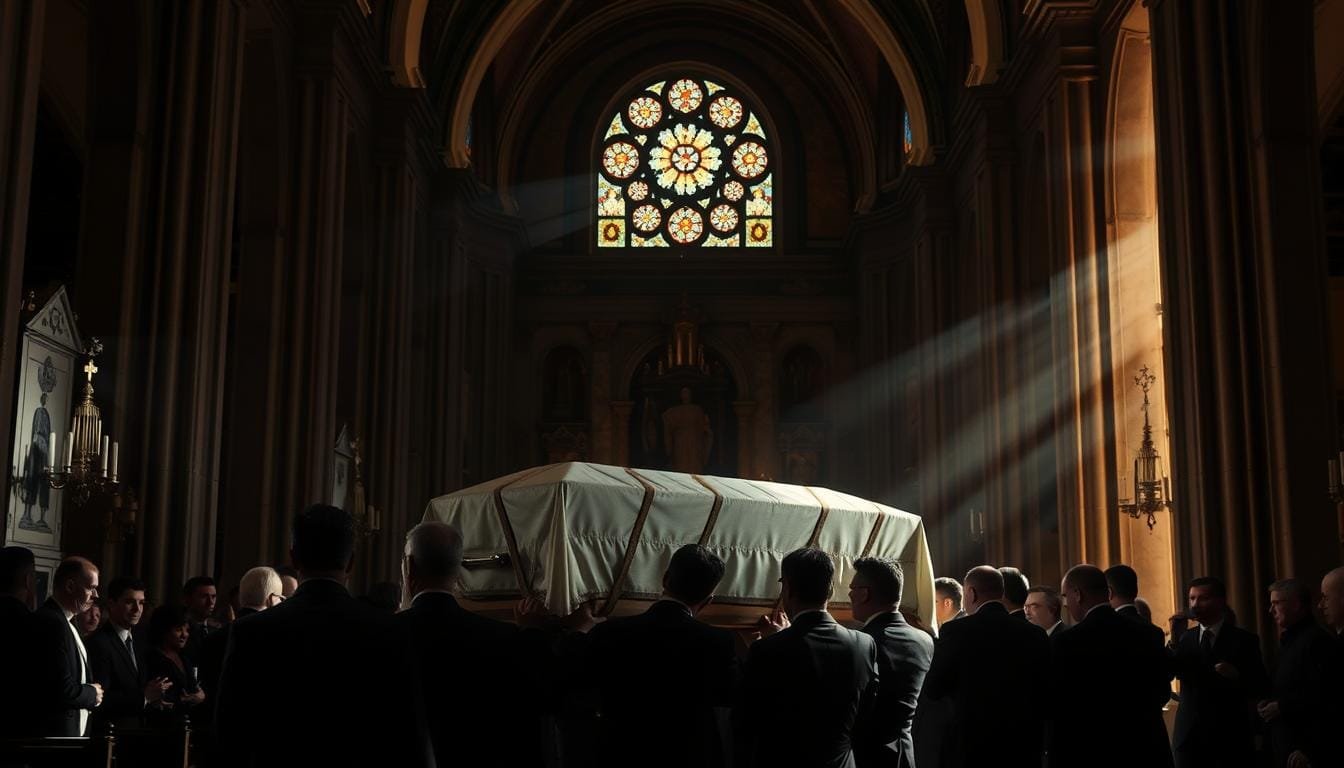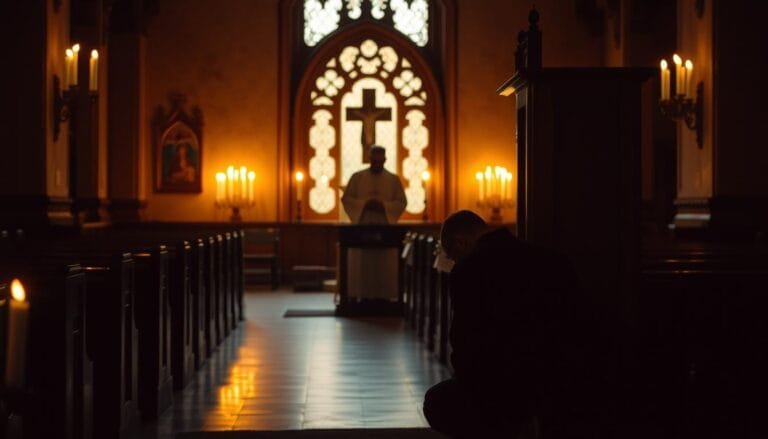Understanding Catholic Funeral Traditions: A Guide to Sacred Rituals
In times of grief and loss, religious ceremonies provide structure and meaning to help mourners process their emotions.
For millions worldwide, Catholic funeral traditions offer a framework of rituals that have evolved over centuries, combining ancient practices with contemporary expressions of faith.
These sacred ceremonies guide the faithful through the difficult journey of saying goodbye to loved ones while affirming the Church’s teachings on eternal life and resurrection.
Key Takeaways
- Cremation is now allowed, but ashes must be buried in a consecrated urn or grave, not scattered.
- A funeral mass is reserved for baptized Catholics, though exceptions exist for unbaptized children and catechumens.
- Eulogies are shared at the vigil service, not during the funeral mass itself.
- Rites like the Rite of Committal ensure the body is revered, reflecting Christ’s victory over death.
- Dark attire and modest floral arrangements honor the somber nature of these catholic funeral traditions.
The Theological Foundation of Catholic Funeral Rites
At the heart of every Catholic funeral lies a deep theological vision. Our traditions show our beliefs about life’s purpose and our eternal union with God.
These rituals are not just customs but expressions of faith in Christ’s resurrection.
Catholic Theology of Death and Resurrection
Our faith says death is not the end but a transition. The catholic belief in resurrection tells us that death leads to eternal life. As Scripture says, “I am the resurrection and the life” (John 11:25).
The sacrifice of Jesus turns death into hope. This truth shapes every prayer and ritual we practice.
Prayers for the Dead and Purgatory’s Purpose
Praying for the deceased comes from our belief in prayers for souls in purgatory. Through Masses, rosaries, and the Office of the Dead, we ask God to purify souls before heaven’s gates.
The Church says: “The catholic prayers for the dead are acts of mercy toward those journeying toward God.” Learn more about these prayers here.
Intercession of Saints in Consolation
In times of grief, Catholics seek comfort from the communion of saints. We ask the intercession of saints and Mary to comfort the departed and the living.
The saints’ prayers, like Mary’s, remind us that death cannot break our bond with loved ones. Together, we trust in God’s mercy to guide all toward resurrection’s dawn.
“Blessed are those who mourn, for they shall be comforted.” (Matthew 5:4)
Catholic Funeral Traditions Throughout History
Looking into the history of catholic funerals shows a mix of old and new. Early days had communal vigils and prayers for the dead.
Now, traditional catholic burial rites mix respect with today’s needs. Our faith has kept the belief in resurrection alive, even as cultures change.
- Early Christians had vigils in homes, showing community support for those grieving.
- The 16th-century Tridentine Mass set up prayers but kept local ancient catholic funeral customs.
- Vatican II (1960s) changed liturgies to focus on hope, making Scripture key to the evolution of catholic funeral rites.
- Now, cremation is okay (since 1963), but ashes must be treated with respect, showing dignity for the body.
Today’s catholic funeral history shows rituals like the Rite of Committal or pall use. These honor both old wisdom and today’s needs.
Even with changes from Latin Masses to vernacular readings, our goal is to comfort families and keep faith in eternal life.
These updates show a tradition that’s alive with history but still holds timeless hope.
The Mass of Christian Burial: The Heart of Catholic Funerals
The Mass of Christian Burial is at the heart of Catholic funerals. It brings families together in hope through Christ’s victory over death.
The ritual has stages: the Vigil (Wake), the funeral liturgy with readings, and symbolic elements like the Paschal candle.

Each part comforts the living and honors the deceased’s journey to eternal life.
“The funeral liturgy should be a dignified, prayerful, and consoling experience for mourners.” – Irish Archdiocese of Cashel and Emly guidelines
The Catholic funeral mass is divided into four key sections. These sections guide us through the ritual and offer comfort and hope.
| Part of the Mass | Purpose |
|---|---|
| Opening Rites | Communal prayer welcoming the deceased into God’s presence |
| Liturgy of the Word | Scripture readings (catholic funeral readings) and homily |
| Liturgy of the Eucharist | Communion and sharing in Christ’s sacrifice |
| Closing Rites | Benediction and final farewell |
The Vigil (Wake) Service
The Vigil, or catholic wake service, is a gathering time for family and friends. Here, prayers, memories, and readings are shared.
The priest sprinkles holy water over the body, symbolizing baptismal grace. This time helps us face grief with hope.
Funeral Liturgy and Eucharist
During the Mass, the Liturgy of the Word includes selected catholic funeral readings, which may include Psalms or Gospel passages.
The homily reflects on the deceased’s life and faith. The Eucharist unites us with Christ’s sacrifice, offering spiritual strength.
Rite of Committal at the Cemetery
The rite of committal at the cemetery includes final prayers. The priest or deacon may recite the Lord’s Prayer, emphasizing trust in God’s mercy.
This moment concludes the earthly journey but affirms eternal life.
Symbolic Elements: Incense, Holy Water, and the Paschal Candle
The Paschal candle, symbol of Christ’s light, stands near the altar. Incense honors the body as a temple of the Holy Spirit, and holy water reminds us of baptismal promises.
These symbols guide us to see death as a sacred transition. Symbolic elements like the Paschal candle and incense embody our faith.
The Sign of the Cross, a gesture of faith, and holy water remind us of baptismal grace. These symbols transform sorrow into hope.
Sacred Burial Practices in the Catholic Faith
Catholic burial practices show great respect for the body as a temple of the Holy Spirit.
The preferred method is to bury them in consecrated ground, like blessed earth or mausoleums. These places, blessed through rituals, show our belief in the resurrection of the body.
Now, Catholic rules allow ashes to be placed in urns in special places, like columbariums or graves.

Scattering remains is not allowed, as Father Patrick Carrion says: “Cremated remains must be treated with the same dignity as a body, reflecting our hope in eternal life.”
- Family plots symbolize enduring bonds, with graves marked by crosses or religious icons.
- Interment practices include blessing the burial site during the Rite of Committal, uniting the community in prayer.
- Green burials align with care for creation while honoring consecrated ground burial principles.
Catholic cemetery traditions also guide grave markers and memorials.
Many families choose inscriptions like “Requiem aeternam dona eis, Domine” (Eternal rest grant to them, O Lord) to express faith in resurrection.
The power of intercessory prayer extends to this phase, as families pray for the deceased’s passage through purgatory.
These practices—whether full-body burial or approved cremation—uphold our sacred duty to care for the body as God’s creation.
By respecting these traditions, we honor the dignity of every life and await the promise of eternal life together.
Conclusion: Honoring the Dead in the Catholic Tradition
Our faith turns the catholic grieving process into a hopeful journey. We honor the dead through rituals like the vigil service and the Rite of Committal.
These remind us that death is not the end but a step towards resurrection.
We support each other in mourning. Attending the vigil service or sending flowers shows love. Visiting graves or praying on All Souls’ Day keeps our loved ones in our hearts.
The Church teaches us to pray for those who have passed, knowing they are on their way to eternal life.
Even with cremation, our traditions remain strong. They connect us across generations. Lighting a candle or saying the Rosary strengthens our faith.
Every action we take shows our commitment to eternal life.
These rituals are more than just customs. They promise community and hope in the face of loss. We affirm eternal life by praying for the deceased and following these traditions.
In every Mass, visit to a grave, and prayer, we remember that death is not the end.






